
Some 500 years ago, Spanish conquistadors led by Francisco Pizarro captured the last Incan emperor Atahualpa. Although a ransom for Atahualpa's release was paid with gold, the emperor was still executed. Soon the conquest of Peru was completed; the indigenous people kept fighting off for a few more decades, but the Spanish had firearms in their hands. This drew a final line under the invasion of the country.
The Spaniards used pieces of platinum, which they first found whilst mining gold, to shoot with. Placer gold was interspersed with the hardly separable silvery-white metal. The Spanish colonisers tried to melt it first, having mistaken the find for silver. Still, after several unsuccessful attempts, they gave up and decided to use platinum for rifles. To express their disdain for the metal, the new rulers gave it a name that translates from Spanish as "little silver".
Melting platinum did not bring any success until it was tried in continental Spain. When jewellers discovered that the metal could be fused with gold, they began to add it to objects and coins. Thereby they could increase the objects' weight whilst using less "yellow metal" for their production. The government eventually became aware of the manipulations. So the king issued an order stating that imports of platinum to Spain should be stopped and remaining reserves drowned. The law was in force during the next four decades, causing over 10 tonnes of the precious metal to be buried off the coast of Colombia.
By the mid-18th century, platinum, as an element, had been thoroughly studied. The metal has several distinguishable characteristics: rarity, exceptional chemical stability, durability, and flexibility. Platinum is also resistant to most acids. Perhaps not as common as silver or gold, platinum, however, started to increase in value. The world began to show interest in the commodity.
Until 1813, the primary supplier of platinum was Colombia, with everything changing when Russia's first nugget of native platinum was discovered. The find was made near a tributary of the Iset river in the Urals, at the gold mining site. A year later, the discovery of gold deposits in the area was confirmed by the mining engineer Lev Brusnitsyn. It became apparent that platinum accumulates therein, too. Egor (Georg) Cancrin, appointed Minister of Finance, decided to capitalise on the coincidence, ordering to mint platinum coins to quickly replenish the Russian treasury devastated by the war with Napoleon. Cancrin had to persuade Nicholas I that using platinum in coinage would be reasonable, though. Hence, he contacted Alexander von Humboldt, a German naturalist and explorer, seeking his approval. Humboldt, who numerously advised European monarchs, was hesitating at first yet changed his mind later. He noted, "Recommend against the experiment means we shall never see a platinum coin issued; is this what platinum deserves?"
Platinum coins were a solution that helped the Russian Empire work its way out of the financial crisis. Over the next 16 years, approximately 40 tonnes of the metal were mined in the Ural Mountains, twentyfold that of Colombia. Despite this, Nicholas I decided to stop the circulation of "platinum money" after hearing the rumours it was being counterfeited abroad and smuggled back into the country. This brought the domestic tradition of platinum mining and processing to an end. The concession was taken over by the British Johnson, Matthey and Co., which did not care much about Ural goldmines that had obviously seen better days. The company concluded contracts on favourable terms: it set prices for the next five years, not taking into account any market changes that might happen. As a result, in the early 20th century, Russian platinum was mainly acquired by foreign-based companies and exported abroad. The first buyers were chiefly British and French companies, later joined by American and German enterprises. In the meantime, platinum prices rose above those reached by gold.
People started to associate platinum with prestige and exclusivity. The British even began to use it to manufacture national symbols. A notable example is the half-kilogramme crown of Queen Elizabeth, made of platinum and decorated with diamonds, including a genuine treasure of the British royal family – the 105-carat Koh-i-Noor. Thus more durable platinum replaced diamond as a primary decoration for silver-based jewel items.
Platinum nuggets are the rarest and most valued. A unique sample of over five kilogrammes in weight is reposited at St. Petersburg Mining Museum. The world's top-5 largest nugget amongst preserved ones originates from the Urals. Another specimen was once presented by Akinfiy Demidov, the owner of Nizhny Tagil factories, to Emperor Nicholas I, who, in turn, handed it over to the museum. The 4.3 kg nugget had remained stored in St. Petersburg until 1907, when it was transferred to Moscow. From then on, it has been on display in the Diamond Fund at the Kremlin, Moscow.
Article revised by Diego Monterrey.




